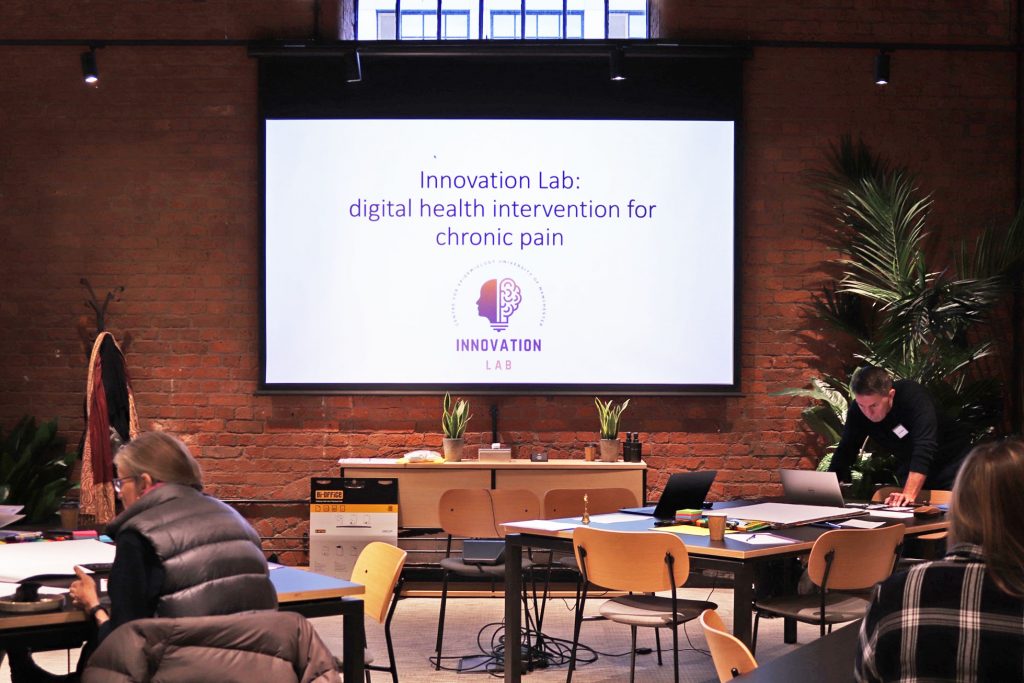
Digital Pain Therapeutics Innovation Lab: Transforming Pain Care Delivery with Digital Health Technology
Article highlights
- Developing an effective personalised intervention with digital health technologies requires clear guidance on how to utilise patient-generated data to tailor support and deliver it to the right person at the right time
- Just-in-time adaptive intervention introduces a personalised approach to delivering tailored support in real-time, but many questions need to be answered before applying to chronic pain management, including how to effectively monitor pain triggers, improve engagement, evaluate behaviour change mechanisms, and define personalised profiles for tailoring
- People with chronic pain can benefit from a multi-level modular intervention that targets various needs provided in a bite-sized and graded format. The long-term goal is to move beyond reducing pain intensity and prioritise the overall impact of pain on individual well-being
While it is encouraging to see that modern medicine has made great progress towards reducing overmedication and taking a more holistic approach to chronic pain, there is still much work to be done to improve the quality of pain care delivery. That is, providing the right support at the right time to the right person.
One potential solution is integrating digital health technologies such as smartphones and wearables. By capturing individual information in real-time, we can better understand the various factors contributing to pain and the dynamic impact in different contexts. Tailored support can be provided based on real-time data to optimise treatment effectiveness. However, it remains unclear how to utilise real-time patient-generated data effectively to develop personalised interventions.
Last year, we established a research initiative called Digital Pain Therapeutics (DPTx), which leverages the growth of digital health technologies to improve the real-world effectiveness of psychological and behaviour change interventions for chronic pain. The initiative consists of three pillars, including real-time data capturing (collecting patient-generated data from digital health technologies), real-time personalisation (providing tailored support that meets individual needs) and real-time support (delivering tailored support directly to patients as needed).
To develop this initiative, we organised a two half-days DPTx innovation lab in November, which brought together 25 experts in chronic pain, pain treatment and management, behaviour change, complex analytics, digital health, health informatics and data governance, as well as public contributors. We discussed the current barriers and opportunities in chronic pain management and explored solutions to developing an effective personalised intervention using just-in-time adaptive intervention (JITAI), an emerging approach created for providing tailored support in real-time. Here we summarise the key points, emerging questions and important considerations raised in our discussion.
Transforming chronic pain management
In reviewing the challenges and barriers faced in chronic pain management, we identified expectations and priorities to be considered when improving pain care
Pain care provision
- Ensuring a balance between needs and qualifications for pain care that prioritises access to support over strict requirements
- Improving care coordination and continuity among healthcare providers
- Enabling consistent and timely delivery of support to maintain patient engagement and prevent pain flares
Therapeutic targets
- Encouraging more informed conversations about setting short-term and long-term well-being goals for managing chronic pain
- Patients may benefit the most from improving their sleep, engaging in physical activity, taking care of their mental health, effectively communicating their pain, and gaining knowledge about self-management
Pain management support
- Using a multi-level modular intervention format allows patients to focus on one specific target at a time while balancing short-term and long-term goals
- Providing bite-sized and graded tasks can potentially reduce user burden and improve engagement
Emerging questions for personalised pain management
Questions that emerged from our discussion were grouped into three themes:
Personalised approach
- What exposures associated with pain should be monitored and how?
- How to define personalised profiles (e.g. pain patterns, exposures, short-term and long-term goals) for tailoring?
- What do patients want to know about their pain?
Intervention codesign
- What digital tools are acceptable to the target population?
- How to best engage patients to monitor their pain?
- What feedback increases engagement?
- How to organise multiple therapeutic targets?
Outcome evaluation
- What can be learned from successful and unsuccessful interventions?
- What behaviour change techniques work? Where? When? How? For whom?
- At what point is the intervention considered effective?

Consideration in designing a JITAI for chronic pain
JITAI consists of six components. Defining each component is the first step. Based on our discussion we provided the following considerations:
Decision points
Time points for deciding whether an intervention should be delivered and how
- An intervention decision should be made when there may be a “significant change” in pain severity
- Defining operational goals for monitoring pain triggers, such as data collection methods and tools, as well as the frequency of engagement
Tailoring variables
Information about end-users that is utilised to determine when and how to intervene
- Tailoring variables should not be limited to individual pain experience, but also users’ receptibility
- Group-level tailoring is a more realistic and feasible approach when individual data is not available
Intervention options
Various support types or delivery modes that can be used at given decision points
- Support and delivery modes should consider individual differences as expectations and priorities change over time
- Providing bite-sized and graded tasks, and offering breaks could minimise engagement burden
Decision rules
Systematic rules linking tailoring variables and intervention options for adaptation
- Effective decision rules depend on the levels at which tailoring variables and intervention options are linked
- Using clusters or subgroups based on similar characteristics at various tailoring levels when individual data is limited
Proximal and distal outcomes
Short-term goals (proximal) often acted as mediators for the primary clinical outcome (distal)
- Using a multi-level modular intervention format that targets multiple needs, such as pain acceptance, perception or functionality
- The distal outcome should move beyond pain intensity and prioritise pain impact and individual well-being
Personalised pain care is gaining traction as healthcare providers and researchers increasingly recognise the complexity and variability of chronic pain. With the continued advancement of technology, personalised interventions for chronic pain become more feasible and accessible.
The DPTx innovation lab explored JITAI as a potential solution to delivering real-time personalised support, but this approach is still in its early stages of development and implementation. We identified various challenges and opportunities that are worth further research, including effective monitoring of pain triggers, engagement with digital health technologies, behaviour change mechanisms and personalised profiles for tailoring. A joint effort between researchers, healthcare providers, and patients is needed to overcome these hurdles and optimise the potential of JITAI.

Relevant files are available for download
DPTx innovation lab summary (PDF)
DPTx innovation lab report (PDF)
Acknowledgement
We would like to thank the funders of this project, including the NIHR Manchester Biomedical Research Centre, Professor Deborah Symmons, the Masood Entrepreneurial Centre and the Centre for Epidemiology Versus Arthritis. We are also thankful for the assistance provided by the Patient Public Involvement networks, namely Dr Katie Druce, the MSK research user network, the REMORA PPI group, and FibroFighters. Finally, our appreciation goes out to all the participants, facilitator and volunteers who contribute valuable insights and constructive feedback.
Our contact






0 Comments